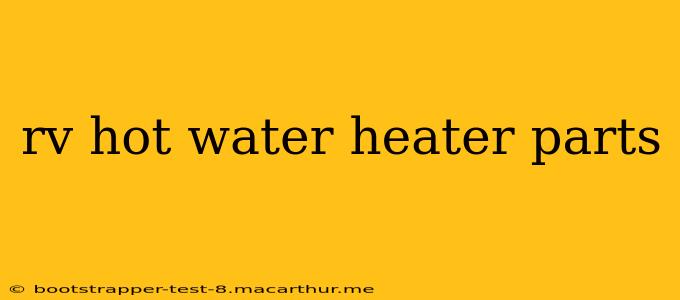Replacing or repairing your RV hot water heater can feel daunting, but understanding the individual parts makes the process much more manageable. This guide will break down the essential components of a typical RV hot water heater, explaining their function and troubleshooting common issues. Whether you're a seasoned RVer or a newbie, this information will empower you to tackle maintenance and repairs with confidence.
What are the main parts of an RV hot water heater?
Most RV hot water heaters, regardless of whether they're gas or electric, share a similar set of core components. These include:
-
Tank: This is the primary vessel holding the water. Made of steel or, less commonly, plastic, the tank's lifespan is typically 8-10 years, depending on usage and water quality. Corrosion is a major enemy of RV water heaters, so regular flushing is crucial.
-
Heating Element (Electric): Electric water heaters use one or more heating elements to heat the water. These elements are submerged in the water and can burn out over time due to mineral buildup or excessive use.
-
Burner (Gas): Gas water heaters utilize a burner assembly to heat the water. This includes the burner itself, a thermocouple (a safety device that senses the flame), and an igniter. Problems with any of these components can prevent the water heater from igniting or staying lit.
-
Thermostat: This crucial part regulates the water temperature. A malfunctioning thermostat can lead to either too hot or too cold water. It's important to check its settings and ensure it's functioning correctly.
-
Dip Tube: Located inside the tank, the dip tube guides cold water to the bottom of the tank, allowing for efficient heating and preventing mixing of hot and cold water. A damaged or clogged dip tube can result in poor performance.
-
Pressure Relief Valve: This safety device releases excess pressure within the tank to prevent explosions. Regular testing is essential to ensure it functions correctly. This is often confused with a drain valve, but serves an entirely different purpose.
-
Drain Valve: Used for draining the tank for cleaning or winterizing, the drain valve is essential for maintaining your water heater. Locate it and learn how to use it properly – this is one of the simplest parts, yet crucial for upkeep.
-
Anode Rod (Sacrificial Anode): This rod attracts corrosive minerals, protecting the tank from rust and corrosion. It's a consumable part and will eventually need replacement. Checking and replacing the anode rod regularly helps extend the lifespan of the tank.
How do I know if my RV water heater needs repair?
Several signs indicate potential problems with your RV hot water heater:
-
No hot water: This could be due to a faulty heating element (electric), burner (gas), thermostat, or even a simple lack of power/gas.
-
Weak hot water: This suggests a problem with the heating element, burner, thermostat, or a buildup of sediment in the tank.
-
Leaking water heater: This is a serious issue that could indicate a cracked tank or a problem with the pressure relief valve. This requires immediate attention.
-
Strange noises (popping, banging): These sounds often point to sediment buildup or a problem with the thermostat.
-
Water heater not lighting: Could signal a problem with the gas supply, igniter, or thermocouple.
What are common RV hot water heater problems?
H2: What causes my RV hot water heater to leak?
Leaks often stem from a corroded tank (especially in older units), a faulty pressure relief valve, or a damaged drain valve. Regular inspection and maintenance, including flushing, can mitigate these issues. A leaking water heater should be addressed immediately to prevent further damage.
H2: How do I winterize my RV hot water heater?
Winterizing prevents freezing and damage to your water heater. This involves draining the tank completely and adding RV antifreeze. Follow the manufacturer's instructions for your specific model. This is especially important in colder climates.
H2: Why is my RV hot water heater not heating?
This could be caused by a variety of issues including a faulty heating element (electric), a problem with the gas supply or burner (gas), a malfunctioning thermostat, or a tripped breaker/low propane. Systematic troubleshooting is key.
H2: How often should I flush my RV hot water heater?
Flushing your water heater annually, or more frequently if you notice reduced hot water or sediment buildup, is recommended to maintain efficiency and prevent corrosion. Regular flushing prolongs the life of your water heater significantly.
By understanding the individual components of your RV hot water heater and addressing potential problems promptly, you can ensure reliable hot water throughout your travels. Remember, regular maintenance is key to extending the life of your water heater and preventing costly repairs down the road.
